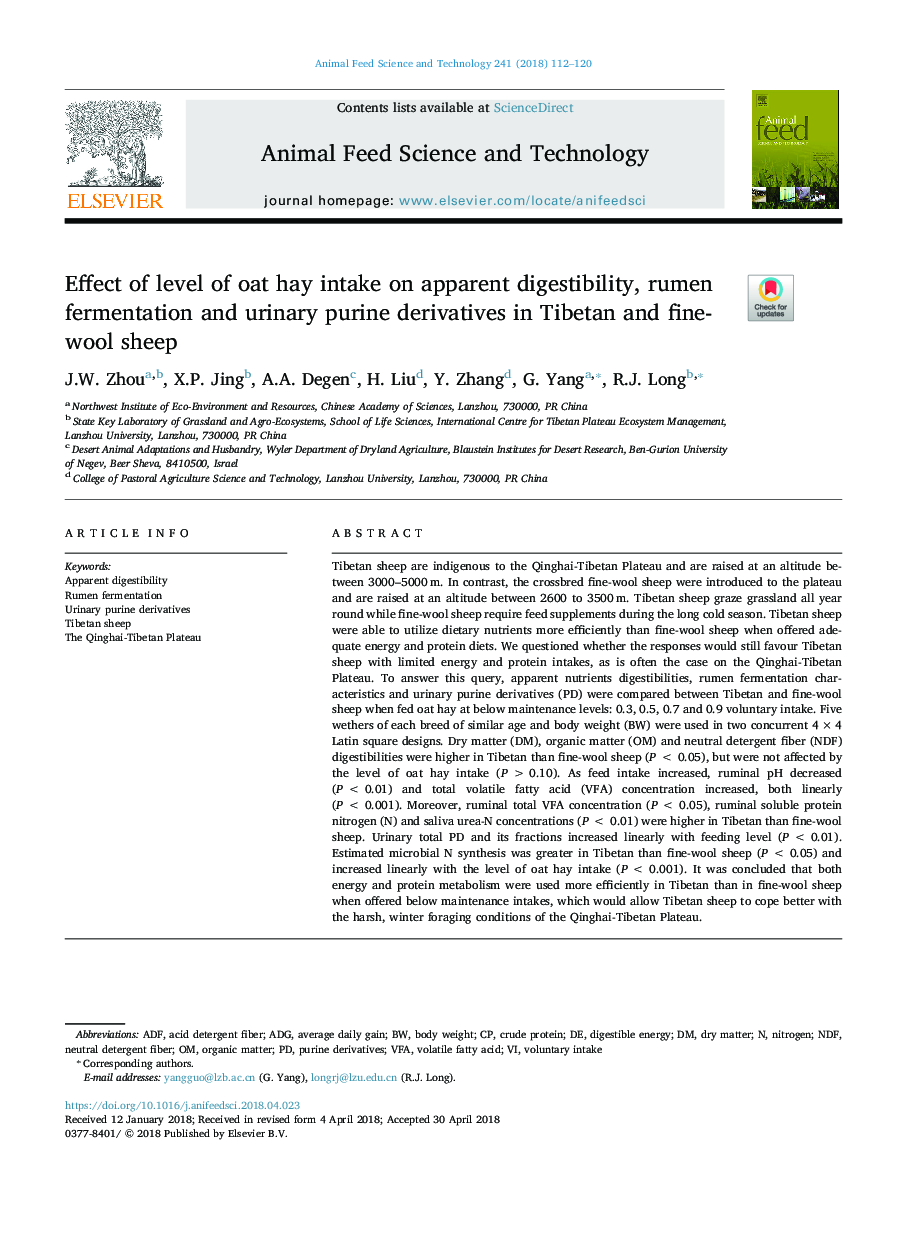| کد مقاله | کد نشریه | سال انتشار | مقاله انگلیسی | نسخه تمام متن |
|---|---|---|---|---|
| 8490935 | 1552345 | 2018 | 9 صفحه PDF | دانلود رایگان |
عنوان انگلیسی مقاله ISI
Effect of level of oat hay intake on apparent digestibility, rumen fermentation and urinary purine derivatives in Tibetan and fine-wool sheep
ترجمه فارسی عنوان
تاثیر میزان مصرف هلو جو دوسر بر قابلیت هضم ظاهری، تخمیر شکمبه و مشتقات پورین ادراری در گوسفند تبت و پشم گوسفند
دانلود مقاله + سفارش ترجمه
دانلود مقاله ISI انگلیسی
رایگان برای ایرانیان
کلمات کلیدی
ADFVFANDFADGvolatile fatty acid - اسید چرب فرارacid detergent fiber - الیاف پاک کننده اسیدDigestible energy - انرژی قابل هضمRumen fermentation - تخم ریزیneutral detergent fiber - فیبر مواد شوینده خنثیThe Qinghai-Tibetan Plateau - قطعه چینگهای-تبتانهorganic matter - ماده آلیdry matter - ماده خشکaverage daily gain - متوسط افزایش روزانهPurine derivatives - مشتقات پورینurinary purine derivatives - مشتقات پورین ادرارVoluntary intake - مصرف داوطلبانهNitrogen - نیتروژنApparent digestibility - هضم ظاهریbody weight - وزن بدنcrude protein - پروتئین خامTibetan sheep - گوسفند تبتی
موضوعات مرتبط
علوم زیستی و بیوفناوری
علوم کشاورزی و بیولوژیک
علوم دامی و جانورشناسی
چکیده انگلیسی
Tibetan sheep are indigenous to the Qinghai-Tibetan Plateau and are raised at an altitude between 3000-5000â¯m. In contrast, the crossbred fine-wool sheep were introduced to the plateau and are raised at an altitude between 2600 to 3500â¯m. Tibetan sheep graze grassland all year round while fine-wool sheep require feed supplements during the long cold season. Tibetan sheep were able to utilize dietary nutrients more efficiently than fine-wool sheep when offered adequate energy and protein diets. We questioned whether the responses would still favour Tibetan sheep with limited energy and protein intakes, as is often the case on the Qinghai-Tibetan Plateau. To answer this query, apparent nutrients digestibilities, rumen fermentation characteristics and urinary purine derivatives (PD) were compared between Tibetan and fine-wool sheep when fed oat hay at below maintenance levels: 0.3, 0.5, 0.7 and 0.9 voluntary intake. Five wethers of each breed of similar age and body weight (BW) were used in two concurrent 4â¯Ãâ¯4 Latin square designs. Dry matter (DM), organic matter (OM) and neutral detergent fiber (NDF) digestibilities were higher in Tibetan than fine-wool sheep (Pâ¯<â¯0.05), but were not affected by the level of oat hay intake (Pâ¯>â¯0.10). As feed intake increased, ruminal pH decreased (Pâ¯<â¯0.01) and total volatile fatty acid (VFA) concentration increased, both linearly (Pâ¯<â¯0.001). Moreover, ruminal total VFA concentration (Pâ¯<â¯0.05), ruminal soluble protein nitrogen (N) and saliva urea-N concentrations (Pâ¯<â¯0.01) were higher in Tibetan than fine-wool sheep. Urinary total PD and its fractions increased linearly with feeding level (Pâ¯<â¯0.01). Estimated microbial N synthesis was greater in Tibetan than fine-wool sheep (Pâ¯<â¯0.05) and increased linearly with the level of oat hay intake (Pâ¯<â¯0.001). It was concluded that both energy and protein metabolism were used more efficiently in Tibetan than in fine-wool sheep when offered below maintenance intakes, which would allow Tibetan sheep to cope better with the harsh, winter foraging conditions of the Qinghai-Tibetan Plateau.
ناشر
Database: Elsevier - ScienceDirect (ساینس دایرکت)
Journal: Animal Feed Science and Technology - Volume 241, July 2018, Pages 112-120
Journal: Animal Feed Science and Technology - Volume 241, July 2018, Pages 112-120
نویسندگان
J.W. Zhou, X.P. Jing, A.A. Degen, H. Liu, Y. Zhang, G. Yang, R.J. Long,
